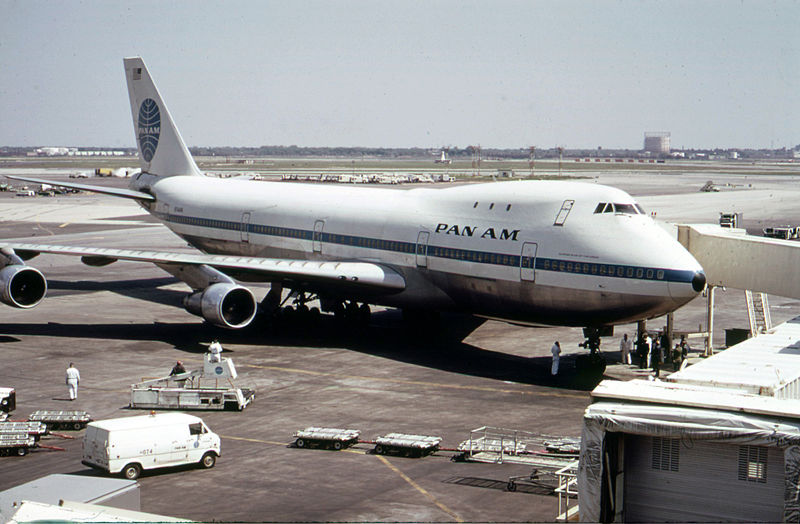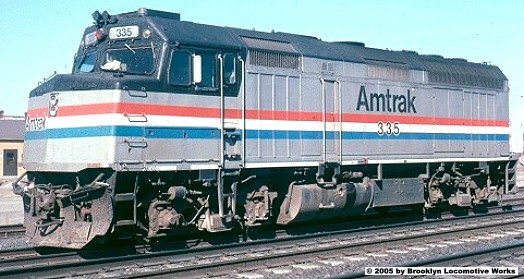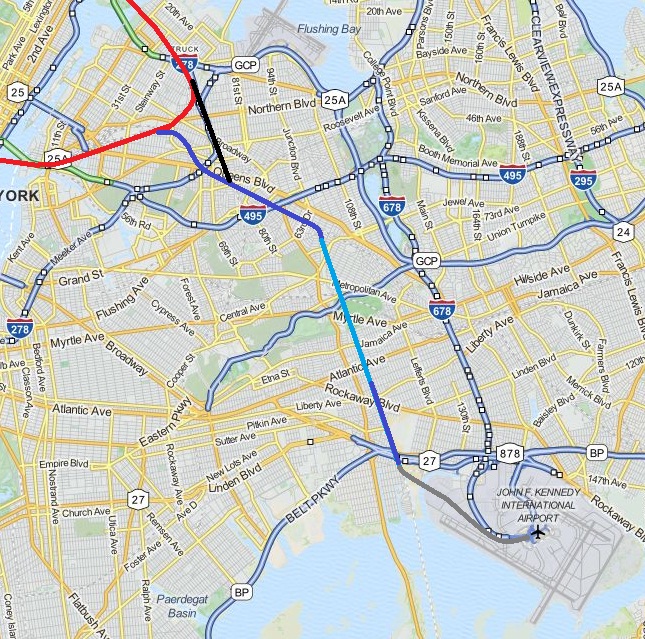1975-1978
The new diesel locomotive for Amtrak
It was 1975 when the first batches of Amtrak's new diesel locomotive (the memorably named "F40PH") started to arrive. These locomotives had been ordered in large numbers to replace Amtrak's old locomotives, and provide some fast and efficient motive power for Amtrak's non-electrified routes - which consisted of almost all routes outside the North East Corridor. The locomotive would prove to be wildly popular for Amtrak, as it's reasonable top speed of 110mph and high power of 3,200bhp meant that it was equally at ease hauling long distance services and hauling commuter services.
It was also in the final weeks of 1975 that "Conrail" (as the Consolidated Railroad Corporation had become known) published their "Final System Plan" - in essence a map of those freight lines it wished to retain, with the rest being disposed off in any manner (although Amtrak had first choice). It had also agreed that Amtrak would be allowed to take on many miles of tracks under the contracted proviso that Conrail would be allowed trackage rights. Conrail hoped that Amtrak would in effect maintain the tracks for them. For the main lines, Amtrak managed to take hold of the ex-Pennsylvania Railroad line from Philadelphia - Harrisburg and some extensions for it's Newark commuter rail. Amtrak also took on large swathes of the commuter rail network, particularly around Boston, New York City, Newark & Chicago, along with smaller segments around Philadelphia, Baltimore & Washington. Although Amtrak had eyes for the ex-New York Central Railroad's Water Level Route from New York City to Buffalo, it was not something Conrail was ready to hand over, being a core part of their network. Realistically, it's doubtful in hindsight whether it would of been advantageous for Amtrak; it would of been a significant undertaking to modernise it for passenger traffic and a lot to maintain it despite there not being a huge potential market on it. Amtrak did come to an agreement to investigate re-quadrupling the line in the future though, so it could be shared between freight and passenger traffic.
It was right at the end of 1975 however, that Amtrak would drop one of it's biggest piece of news for the decade, that involved 3 players.
- Pan-American World Airways, commonly known as "Pan-Am". Pan-Am were an ailing airline, struggling to compete due to their lack of a domestic network in the US to act as a feeder network into it's main international routes. It was hamstrung by it's reputation and it's legal inability to act domestically within the USA, with competitors loathe to willingly accept changes in the status quo.
- New York State, or more precisely Long Island. New York JFK Airport is an incredibly busy airport, but is situated out on Long Island. The lack of public transport to the airport caused frequent jams on Van Wyck Expressway and Grand Central Parkway, causing frustration for Long Island residents.
- Amtrak, the passenger rail operator, who was looking for further means to maximise the amount of people using it's trains, and therefore increase revenue.
What was proposed was a new rail link, from Penn Station (with a chord to face Boston as well), sharing the Long Island Railroad right-of-way (but not it's tracks) and then using the former Rockaway Beach Branch to access JFK Airport, where it would then run underneath the runways and terminate in an underground station with direct links into Pan-Am's Worldport at the airport - and most importantly integrated baggage systems. The original idea, which would in later years be looked back on with admiration at such forward thinking, was that people could check in for their flight at New York Penn Station, check their baggage in, which would be conveyed directly into the baggage systems at Pan-Am's Worldport. Pan-Am passengers would then catch their train to JFK and walk straight through for international departures.
Amtrak quickly built on this; it foresaw an opportunity to not just allow check in at New York Penn, but all the other major stations along the North East Corridor; New York Penn, Newark Penn, Philadelphia 30th, Baltimore Penn & Washington Union station. Baggage could also be conveyed in reverse, if an agreement with US Customs for a customs zone at each of the 5 stations after people had collected their luggage could be reached. The idea won the swift approval of all 3 parties, with New York State agreeing to fund part of the plan as part of it's anti-congestion plans. Pan-Am would largely fund the airport station works, with Amtrak picking up the rest. The result for Pan-Am would be to gain a huge catchment area for it's flights from JFK Airport, crucial at such a financially woeful time in the airline's history, and for Amtrak to gain all those extra passengers; Amtrak would even allow Pan-Am to retail tickets on their behalf. The parties involved planned for the "JFK Air Rail Link" to open in 1980.
All this was set against the background of President Ford's signing in of the "North East Corridor Renovation Plan", in 1976 (cruelly derided as a "NECRomancy Plan" by opponents of the day who saw it as trying do magically bring a relic from another time back to life). After Amtrak's hard lobbying to Congress for funds to renovate the North East Corridor, Congress had bundled funding for Amtrak together with Conrail in order to re-signal most of the line to allow faster trains and better utilisation, as well as full electrification. The section from New York to Boston would be electrified with overhead cables at 25kV @ 60Hz, with the stretch from New York to Washington updated to the same electricity standard. The package also came with the funding for the investment into electric locomotives which Amtrak had been researching. In return, the Act stipulated firm goals for Amtrak; to offer transit from Washington to New York in 2:40 and New York to Boston in 3:40. Amtrak borrowed money as well in order to fund track maintenance in order to make the North East Corridor as fast as it could manage.
After Amtrak's studies into electric traction, it was decided to order EMD AEM7 locomotives. These were mostly as powerful as the ex-PRR GG1 electric locomotives that Amtrak were now relying on to haul Budd Metroliners on the Washington DC - Amtrak stretch, but significantly lighter, resulting in a very high horsepower-to-weight ratio. The locomotives had a top speed of 125mph, and the light but powerful factor meant it was quick accelerator - very important on the North East Corridor with plenty of stations.
In the Mid-West, Amtrak's alterations to Chicago Union were bearing fruit by the start of 1978, with the through platforms coming into usage. This made a huge difference when combined with the new F40PH locomotives. Now trains could pull into Chicago from their point of departure, and leave 2-3 minutes later to continue on to their destination instead of sitting in Chicago for a length of time while locomotives were swapped around, refueled. Due to the longer distance to Detroit and Cleveland, it had been decided that Minneapolis - Milwaukee - Chicago services would be merged with Chicago - Indianapolis - Cincinnati / Lousiville services and run with the new F40PH locomotives and new Amfleet passenger coaches. Turboliners - the first generation batch and a second generation that had been delivered in 1976/1977 would remain in service to Detroit & Cleveland on that route due to the greater ease of turning the train round at it's terminal points - simply walk to the other end of the train!

Pan-Am World Airways, Amtrak's new partner, at the JFK Worldport
----------------------
Notes: The Pan-Am / Amtrak link up is the biggest butterfly so far. Amtrak desperately wants to spur additional usage of it's trains. Pan-Am desperately wants a feeder network into it's hub at JFK. Long Island is experiencing large congestion due to airport traffic. There's no new right-of-way needed (although LIRR is reduced to 4 tracks from 6 through Woodside station). Amtrak will have it's work cut out from 1975-1980 as pretty much all it's efforts go into NEC improvement:
- The JFK Rail Link (right-of-way exists, Pan-Am largely paying for the airport station, Amtrak largely paying for approach work with some New York funding)
- Electrification from New York to Boston (project actually signed into law by Ford in 1976, project later withdrawn due to Reagan cuts to Amtrak), with conversion to 25kV on the Washington DC to New York section
- Resignalling (the entire NEC converted to colour light signalling slowly but sure - resignalling occured OTL anyway in the late 1970s)
Just explaining that to try and show it's not a complete Amtrak-wank

We'll see how far that gets over the next few chapters. Other butterflies: larger areas of commuter rail passed to Amtrak from Conrail. Reading Railroad was largely ignored by Conrail (as you can see on the OTL FSP), so that's a nice snatch for Amtrak. Around 1980 I'm thinking of doing a sweep across the commuter rail operations to see where they serve.
Here's a quick map of the JFK link I knocked up to show the route:
Red: Existing NEC
Upper Purple: Alignment shared with LIRR
Light Blue: Abandoned alignment
Lower Purple: Alignment shared with NYC Subway
Grey: New alignment in tunnels underneath runway and station at Worldport
Black: The JFK-Boston link; tentatively using the Bay Ridge Branch. Rest of Bay Ridge Branch maybe converted to Amtrak commuter line for NYC in future.
As ever, feedback/corrections welcome!


